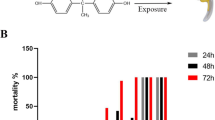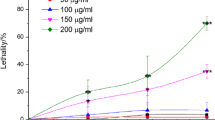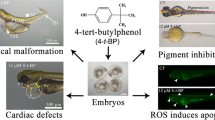Abstract
The xanthene class of Erythrosine B (ErB) is a well-recognized color additive that has been used in drugs, foods and cosmetics. ErB is described as inhibitors of protein–protein interaction and is toxic to reproductive and developmental processes. However, the available toxicological information was inconclusive to access the potential risk of ErB to aquatic and other living organisms. Hence, in this study, we investigated the toxicological impacts of ErB by utilizing zebrafish embryos as model organisms. The developmental deformities including survival, hatching, heart rate, malformation and histological changes were evaluated at specific time intervals (12, 24, 36, 48, 60, 72, 84 and 96 hpf), and the oxidative stress markers [catalase (CAT), superoxide dismutase (SOD), glutathione S-transferase (GST) and glutathione peroxidase (GPx)] were also measured to ascertain the relationship between ErB and reactive oxygen species (ROS). The results depict that ErB was found to exert a concentration-dependent (1, 10, 50, 100, 1000 g mL−1) toxicity to zebrafish embryos by reducing the survival (45.3 ± 11.7%), hatching (45 ± 11.12%) and heart rate (49.4 ± 5.2% at 60 hpf) along with significantly induced malformation at 96 hpf. Moreover, the activities of antioxidant enzyme levels (CAT, SOD, GST and GPx) were significantly (P < 0.05) reduced in ErB at 1000 µg mL−1 exposed embryos which clearly stating the generation of ROS by ErB. Similarly, morphology and histological patterns further validate that ErB was found to induce severe abnormalities to zebrafish embryos and/or larvae in a dose-dependent manner. Hence, our preliminary findings show the evidence on the toxicological impacts of food additive ErB against developmental stages of zebrafish embryos through its ROS-mediated pro-oxidant effects.







Similar content being viewed by others
References
Aeschbacher HU (1990) Genetic toxicology of food products. Prog Clin Biol Res 340:117–126
Ames BN (1986) Food constituents as a source of mutagens, carcinogens, and anticarcinogens. Prog Clin Biol Res 206:3–32
Antkiewicz DS, Burns CG, Carney SA, Peterson RE, Heideman W (2005) Heart malformation is an early response to TCDD in embryonic zebrafish. Toxicol Sci 84(2):368–377
Apostol LC, Pereira L, Pereira R, Gavrilescu M, Alves MM (2012) Biological decolorization of xanthene dyes by anaerobic granular biomass. Biodegradation 23(5):725–737
Bakkers J (2011) Zebra fish as a model to study cardiac development and human cardiac disease. Cardiovasc Res 91(2):279–288
Bancroft JD, Gamble M (2002) Theory and practice of histological techniques, 5th edn. Churchill Livingstone, New York
Bergmeyer HU (1974) D-glucose. Methods Enzymatic Analysis 3:1196–1198
Bora SS, Radichevich I, Werner SC (1969) Artifactual elevation of PBI from an iodinated dye used to stain medicinal capsules pink. J Clin Endocrinol Metab 29(9):1269–1271
Brand M, Granato M, Nüsslein-Volhard C (2002) Keeping and raising zebrafish. Zebrafish 261:7–37
Chakraborty C, Hsu CH, Wen ZH, Lin CS, Agoramoorthy G (2011) Effect of caffeine, norfloxacin and nimesulide on heartbeat and VEGF expression of zebrafish larvae. J Environ Biol 32(2):179–183
Collins TF, Black TN, O’Donnell MW Jr, Shackelford ME, Bulhack P (1993) Teratogenic potential of FD & C Red No. 3 when given in drinking water. Food Chem Toxicol 31(3):161–167
Dixit S, Purshottam SK, Khanna SK, Das M (2011) Usage pattern of synthetic food colours in different states of India and exposure assessment through commodities preferentially consumed by children. Food Addit Contam 28(8):996–1005
Ganesan L, Margolles-Clark E, Song Y, Buchwald P (2011) The food colorant ErB is a promiscuous protein–protein interaction inhibitor. Biochem Pharmacol 81(6):810–818
Gupta VK, Mittal A, Kurup L, Mittal J (2006) Adsorption of a hazardous dye, erythrosine, over hen feathers. J Colloid Interface Sci 304(1):52–57
Habig WH, Pabst MJ, Jakoby WB (1974) Glutathione S-transferase the first enzymatic step in mercapturic acid formation. J Biol Chem 249(22):7130–7139
Halliwell B (1994) Free radicals, antioxidants, and human disease: curiosity, cause, or consequence? Lancet 344(8924):721–724
Hsu T, Huang KM, Tsai HT, Sung ST, Ho TN (2013) Cadmium (Cd)-induced oxidative stress down-regulates the gene expression of DNA mismatch recognition proteins MutS homolog 2 (MSH2) and MSH6 in zebrafish (Danio rerio) embryos. Aquat Toxicol 126:9–16
Kimmel CB, Ballard WW, Kimmel SR, Ullmann B, Schilling TF (1995) Stages of embryonic development of the zebra fish. Dev Dyn 203(3):253–310
Knudsen IB (1986). Genetic toxicology of the diet (No. CONF-8506389--). Alan R. Liss Inc, New York
Lowry OH, Rosebrough NJ, Farr LA, Randall RJ (1951) Protein measurement with the Folin-phenol reagent. J Biol Chem 193(1):265–275
Luenloi T, Chalermsinsuwan B, Sreethawong T, Hinchiranan N (2011) Photodegradation of phenol catalyzed by TiO2 coated on acrylic sheets: kinetics and factorial design analysis. Desalination 274(1–3):192–199
Manigandan K, Jayaraj RL, Jagatheesh K, Elangovan N (2015) Taxifolin mitigates oxidative DNA damage in vitro and protects zebrafish (Danio rerio) embryos against cadmium toxicity. Environ Toxicol Pharmacol 39(3):1252–1261
McCann D, Barrett A, Cooper A, Crumpler D, Dalen L, Grimshaw K, Kitchin E, Lok K, Porteous L, Prince E, Sonugabarke E, Warner JO, Stevenson J (2007) Food additives and hyperactive behaviour in 3-year-old and 8/9-year-old children in the community: a randomised, double-blinded, placebo-controlled trial. Lancet 370(9598):1560–1567
Minioti KS, Sakellariou CF, Thomaidis NS (2007) Determination of 13 synthetic food colorants in water-soluble foods by reversed-phase high-performance liquid chromatography coupled with diode-array detector. Anal Chim Acta 583(1):103–110
Misra HP, Fridovich I (1972) The univalent reduction of oxygen by reduced flavins and quinones. J Biol Chem 247(1):188–192
Mizutani T (2009) Toxicity of xanthene food dyes by inhibition of human drug-metabolizing enzymes in a noncompetitive manner. J Environ Public Health 2009:1–9
Mpountoukas P, Pantazaki A, Kostareli E, Christodoulou P, Kareli D, Poliliou S, Mourelatos C, Lambropoulou V, Lialiaris T (2010) Cytogenetic evaluation and DNA interaction studies of the food colorants amaranth, ErB and tartrazine. Food Chem Toxicol 48:2934–2944
Ohgaki H, Hasegawa H, Suenaga M, Sato S, Takayama S, Sugimura T (1987) Carcinogenicity in mice of a mutagenic compound, 2-amino-3, 8-dimethylimidazo [4, 5-f] quinoxaline (MeIQx) from cooked foods. Carcinogenesis 8(5):665–668
Revankar MS, Lele SS (2007) Synthetic dye decolorization by white rot fungus, Ganoderma sp. WR-1. Bioresour Technol 98:775–780
Rotruck JT, Pope AL, Ganther HE, Swanson AB, Hafeman DG, Hoekstra WG (1973) Selenium: biochemical role as a component of glutathione peroxidase purification and assay. Science 179:588–590
Selderslaghs IW, Van Rompay AR, De Coen W, Wittersa HE (2009) Development of a screening assay to identify teratogenic and embryotoxic chemicals using the zebrafish embryo. Reprod Toxicol 28:308–320
Tanaka T (2001) Reproductive and neurobehavioural toxicity study of ErB administered to mice in the diet. Food Chem Toxicol 39(5):447–454
Valavanidis A, Vlahogianni T, Dassenakis M, Scoullos M (2006) Molecular biomarkers of oxidative stress in aquatic organisms in relation to toxic environmental pollutants. Ecotoxicol Environ Saf 64:178–189
Westerfield M (1995) The zebrafish book: a guide for the laboratory use of zebrafish (Brachydanio rerio). University of Oregon Press, Eugene
Xia TA, Zhao Y, Sager T, George S, Pokhrel S, Li N, Schoenfeld D, Meng HA, Lin SJ, Wang X, Wang MY, Ji ZX, Zink JI, Madler L, Castranova V, Lin S, Nel AE (2011) Decreased dissolution of ZnO by iron doping yields nanoparticles with reduced toxicity in the rodent lung and zebrafish embryos. ACS Nano 5:1223–1235
Zhang H, Cai C, Shi C, Cao H, Han Z, Jia X (2012) Cadmium-induced oxidative stress and apoptosis in the testes of frog Rana limnocharis. Aquat Toxicol 122:67–74
Zhao X, Wang S, Wu Y, You H, Lv L (2013) Acute ZnO nanoparticles exposure induces developmental toxicity, oxidative stress and DNA damage in embryo-larval zebrafish. Aquat Toxicol 136:49–59
Acknowledgements
We gratefully acknowledge our colleagues in the zebrafish field for their collective contributions, with special thanks to all members of Elangovan Lab. We appreciate Dr. Arunachalam Muthaiyan, Division of Arts and Science, University of New Mexico – Gallup, Gallup, NM 87301, USA for critical reading of the manuscript. This research did not receive any specific grant from funding agencies in the public or commercial sectors.
Author information
Authors and Affiliations
Corresponding author
Ethics declarations
Conflict of interest
The authors declared no conflicts of interest.
Rights and permissions
About this article
Cite this article
Dharmar, M., Krishnan, N., Thangavel, M. et al. Erythrosine Induces Teratogenic Effects Via Activation of ROS Biogenesis in Zebrafish Embryos. Iran J Sci Technol Trans Sci 43, 763–771 (2019). https://doi.org/10.1007/s40995-018-0612-y
Received:
Accepted:
Published:
Issue Date:
DOI: https://doi.org/10.1007/s40995-018-0612-y




